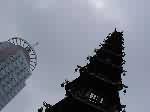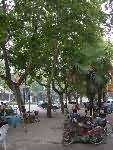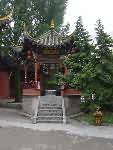- Getting around Lijiang. Dont stay in the Old Towns more than 2 days, there is nothing to do. KRISS Oct 9, 2013 05:46
- 2013 Beijing Temple Fair BENNYLAU Feb 26, 2013 03:29
- Malaysian traveling from KUL - LAX vis Shanghai PVG ZATI_DY Jan 3, 2013 20:15
An Unconventional Route Part Two - Stopping in Hefei
- Views: 5678
- |Vote: 2 1
- |Add to Favorites
- |Recommend to Friends
The Way to Hefei
On my trip from Dalian to Changsha to visit my old friend Lao Hei, I had decided to avoid crowds and overbooked trains by taking a side route through Shandong. Missing a direct train link from Qingdao, I had needed to resort to an overnight bus stopping halfway at Hefei city, capital of Anhui province.
A stop in Anhui was unexpected, and I hadn't really prepared or read up anything about where I was headed. I knew that the city of Hefei was an instrumental locale in the Three Kingdoms war, and that Anhui province is exceptionally poor; apart from that, I had little idea of what I might see there. There's good reason: Hefei is seldom visited by foreign travellers and little information in English is available for the casual China reader. Most China enthusiasts will be rather more familiar with the star attraction of Anhui's south – Huang Shan, one of the most famous and scenic mountains in the whole of China.
In fact, Anhui is dotted with smaller towns of immense aesthetic appeal, most of which are practically unknown to non-Chinese tourists. For those who are serious about getting to know China, and who like to stay away from the other foreign backpackers and destinations pre-packaged for the consumption of rich guests, Anhui is one place that offers continuously rewarding travel and a degree of independence that's difficult to find when you're travelling in a group. Most of these are to be found in the south, although there are a few treasures in the northern parts too. Hefei, quite far to the north of Anhui, is not generally considered to be one of them, and is generally regarded to be an economic and transport centre only.
The journey there was longer than it seemed from looking at the map: one imagines that a direct highway into Hefei would save half a day's travel; as it was, the old, winding roads were tough on the vehicle and progress was slow. The bus itself wasn't in the best of repair and matched the surface of the roads. It was a jumpy, rickety thing that inside resembled a human bookcase: instead of seats, slim, one-person beds were set three-high on a precarious steel tube framing. I shuffled on to my top bed, pushing my bag to the foot end, which reduced its length significantly, and lay with my knees up as the bus set off.
Qingdao with its old, attractive Germanic architecture swiftly fell away from the windows of the bus. And before long I was out once again in the Shandong countryside, great sprawling fields of green and the ochre of rich earth, the bus bumping along the gravely road impolitely laid between them.
I don't know how long I lay there thinking or whether or not I fell asleep: all I know is that when the bus came to a stop it was already deep night, and we were miles away from any city: the weight of the silence of the countryside seemed to crush on the bus as it hushed to a still. We had arrived at a remote restaurant for dinner – I got off from the bus and looked around to find that the restaurant was the only light in sight save the stars above us and the headlights of the bus. It was a strange building, a small brick hall, and behind it, a stone chimney, thick and tall like a skyscraper. The light from the windows of the restaurant reflected underneath the smoke billowing from the top making shadows of light against the sky. Inside, a small counter and a few picnic tables were the only furnishings: I spent a few kuai on a fried eggplant dish and sat with all the other passengers – I'd been so hungry that my simple dish seemed a feast and the company of travellers a congregation of happy festival-goers, and all in the darkness of remote, rural China. This is what it feels like to be happy, and free. This is what travellers are all hoping to find.
From the Bus
I slept on a good meal, and awoke early, just as we were pulling into Hefei. I was groggy and confused: looking at the windows, I couldn't make sense of what I was looking at. As I started putting together the pieces, I began to feel very uncomfortable. Outside was a mess: mud roads, unfocussed crowds of hot-faced men and women in old clothes; the general disarray and bleak chaos told of lives spent in unthinkably poor, crowded conditions, the kind travellers passing through China on luxury tours rarely face, and the kind serious travellers usually describe as 'beautiful, simple existences'. There are times on the road when you suddenly realise that there are communities out there in the world – millions of them – conceivably more than the rest of us – who live miserably. The most common, and perhaps inexplicable reaction to these moments of realisation is fear. The world is not as you believe it to be.
I'd thought that I was already in central Hefei, but of course, I was just on the outskirts. Living conditions improved as the bus shuttled further into Hefei, and before long I was in a regular Chinese provincial capital, the same uniform apartment blocks, tree-lined avenues and merchant bicycle carts that can be found throughout the country.
I stepped into a very pleasant Hefei morning on a leafy street in the northwest of the city. City central is totally different from the outer suburbs, lovingly tiled streets are swept clean in front of colourful new apartment buildings of the classical style front I'd seen go up all over Dalian. I bought a few steamed buns for breakfast and hopped on a bus headed up Shengli Road to the city's new train station, constructed to cope with increasing rail traffic through the region. Shengli Road is wealthy and clean. I passed the broad Victory Square with its giant monument in the shape of a 'zhongguo jie', or traditional Chinese red knot, perhaps in celebration of what seemed to be the city's new, attractive look.
I hadn't been hopeful of getting a train to my intended destination – Changsha – given that tickets are so hard to buy during any holiday period. The only train available was much too crowded and slow, and I'd have to stand the whole night's journey. Without feeling overly defeated, I took the same number bus back to the long-distance bus station and found an appropriate ticket there, leaving in the mid-afternoon, and arriving in Changsha the next morning.
Mingjiao Si
My compensation for taking a route to Changsha that ended up taking a day longer than I'd planned was a chance to see a new city, and I hoped to make the most of the few hours I had to explore a little. A local map revealed that Hefei central is encircled by water rings of a river and ponds, and beyond those a series of ring roads not unlike the ring road systems of Beijing and Chengdu. I wouldn't have enough time to explore widely, but I'd at least have the opportunity to walk through the northeast sector, where the most interesting attractions are to be found.
The bus station is close to the river, and I strolled over a smart white bridge, styled like a suspension bridge, across into Shouchun Road, admiring a strong, angular statue of a hero in the park to my right. Xiaoyao Jin Park is an attractive garden of pagodas and streams, and it was here, my guidebook told me, that the defeated Sun Quan of the Wu army escaped death by leaping across a river on horseback, about 1300 years before.
Very close to the park, on Huaihe Road, is Hefei's star tourist attraction, the Mingjiao Temple. Now regarded as Hefei's main shopping drag, Huaihe Road has been turned into a vast pedestrian mall, cleanly tiled and spaciously constructed. The temple stands incongruously amongst the department stores, and the sweet little marble bridge preserved several paces in front of the temple yard now crosses nothing, as all around and underneath it has been covered in concrete tiling.
The temple is a stately and graceful exception to the new economic bustle of Huaihe Road. I wandered through the various little courtyards and reflected on the history of the place – again, my guidebook informed me that the temple was built in the Qing Dynasty on an old martial training platform, and that the old well, scoured by centuries of rope wear, dates from the Three Kingdoms war also. The temple is also home to an ancient bell of deep spiritual significance – both the well and the bell are kept on display but away from public touch by partitions of glass.
I ate at the Buddhist vegetarian restaurant adjoining the temple, a relaxing but expensive experience, and set about my last hour in Hefei wandering the streets. Hefei may be a poor capital, but under East China's condition of new prosperity, the city has developed quickly and much attention and care has been given to beautifying the area. As I wandered back towards the station to catch my last bus to Changsha, I found myself hoping that the economy of Hefei would provide some finances to finally make a difference to the lives of those struggling for subsistence in rural Anhui.






 Copyright © 1998-2025 All rights reserved.
Copyright © 1998-2025 All rights reserved.
1.
Oct 7, 2005 22:18 Reply
PEA28COCK said:
Finally I have the second part of your story. I like reading your article. It is rather edificatory.
2.
Oct 7, 2005 11:54 Reply
WOCCA said:
This review is easy to read. It flows well.
You've added a very pleasant, personal touch to this narrative ...
3.
Oct 7, 2005 09:46 Reply
JABAROOTOO said:
I'm glad you didn't keep us waiting too long for the end of this story. You never know what to expect when you've on the road. Flexibility is the key.